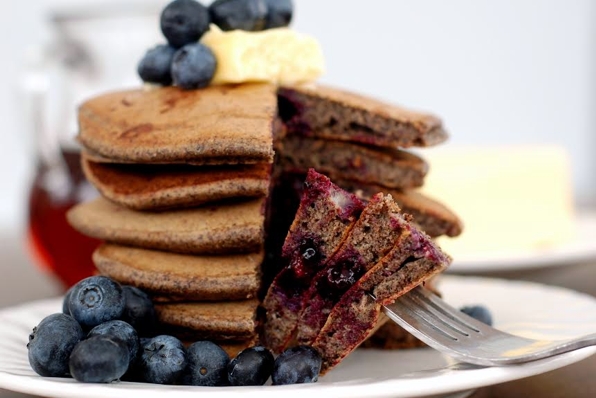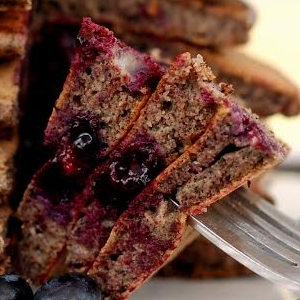I still get this question, in spite of having answered it at least a hundred times. A hundred times? Why the heck haven’t I just written a blog post so I can simply point people to it? All righty, then. Here’s everything you ever wanted to know about Baking Powder and Baking Soda and where the twain do meet…
 A nice tall stack of fluffy, dark spicy pancakes. If you want to include fruit or other goodies
A nice tall stack of fluffy, dark spicy pancakes. If you want to include fruit or other goodies
in yours, as shown above, always sprinkle the additions on top just before your turn
your pancake. The goodies will just sink to the bottom and burn, otherwise…
Remember when you made the Baking Soda Volcano or rocket in science class? That stunt showcased the power of a violent chemical reaction. Add Vinegar to Baking Soda and you got an explosion of frothy bubbles. Well, tamed down a bit, that’s what we do when we use it as a leavening agent in cakes and other baked goods.
What we do…
Baking Soda is the key ingredient, here. When mixed with an acid, it reacts enthusiastically creating Carbon Dioxide (CO2). That’s a gas, and it’s what makes cakes and other baked goodies tall and fluffy. Baking soda is actually present in Baking Powder, too, except there ar othger ingredients, there.
Baking Powder is a blend of Baking Soda and a dry acid. The acid is usually Cream of Tartar (Tartaric Acid) but can be any acid that has the right reactivity with a given mass of Baking Soda. That’s chemistry. All you have to know is that, in most cases, the amount of Baking Powder specified in a recipe is what you need to get results like the picture. There are usually other ingredients in Baking Powder, to keep the Soda and Acid from reacting with each other before you want them to. Those are usually Cornstarch and or Alum, both of which help ‘keep your powder dry’.
Add Baking Soda?
Does your recipe say to add Baking Soda, although you’re already adding Baking Powder, it’s because the ingredients acidic, meaning that the balance between Acid and Soda in the Baking Powder will be skewed. You need more Soda to ensure all the acid in the mixture is reacted out with acid or your recipe may turn out with an annoying sour flavour. Too much Soda, though, and your cookies may taste metallic or salty.
What they did in days of yore…
Back when the reaction of Baking Soda and Acid was first discovered, bakers had to measure their own Acid and Soda, and that was a pain. Results were often inconsistent, not only because measurement was an inexact science back then, but because the purity of your Soda and Acid ingredients was inconsistent – at least compared to their modern day counterparts. Baking Powder, which had all the ingredients pre-measured and combined, ready to toss into we\t batter, was the breaktrhough that got a lot of women baking more than just Bread and Pies at home.
Self-rising Flour
The nest step, of course, was Self-Rising Flour. That’s really just All-Purpose Flour with Baking Soda and Acid added inappropriate amounts. Even easier than Adding your own Baking Powder, and the is evolution spawned a whole host of ‘instant baking mixes’ (IBMs). IBMs eventually evolved to the point where all you had to do was add water and grease the pan. Cookies, Muffins, Cakes. All your fingertips thanks to IBMs.
Want to go retro, just for fun?
I make these retro ‘Homestead Pancakes’ every couple of Saturdays for breakfast. Makes 8 x 6 in. – 7 in. / 17 cm – 20 cm Pancakes
4 cups Bread Flour (or All-Purpose, if that’s all you have)
1 cup Whole or 2% Milk, room Temperature
1 cup Tap Water, hot
1 tbsp. / 15 ml Lemon Juice or White Vinegar
One Large Egg
1 tsp. / 5 ml Salt
1 tbsp. / 15 ml Sugar
1 tbsp. / 15 ml Baking Powder
2 tsp. / 10 ml Cinnamon
2 tsp. / 10 ml Nutmeg
1 tsp. / 5 ml Cloves
First… Mix all the dry ingredients together in a large steel or glass bowl. Whisk to incorporate some air and ensure that all the dry ingredients are thoroughly blended.
Second… Add the Lemon Juice to the Hot water and set aside for the moment…
Third… Crack the Egg into the cup of milk and stir briskly with a fork until well-blended.
Fourth… Add the Milk Mixture to the Dry Ingredients and stir with the handle of a wooden spoon until the moisture is pretty much all taken up. Then, add the Hot Water Mixture and stir until you can get a whisk into the batter and start whisking. Add more Hot Water in 1/4 cup / 80 ml splashes needed to make the batter the consistency you like. Don’t over-whisk – just blend until all the dry ingredients are all wetted.
Note… the enthusiastic bubbling and fizzing the Batter makes! This is Baking Soda Power in practice!
Set the batter aside to age a bit (allow the Baking Soda / Acid reaction to complete itself)
Get your pan or grill pre-heated to 325 – 350 F.
I use a 4 oz./ 120 ml Ice Cream scoop to portion out batter in single-flapjack servings. The Batter also goes onto the pan in a much more orderly and consistent manner with the scoop, making nice, same-sized, round cakes every time.
Serve with whatever Pancake toppings you like…
A guaranteed crowd-pleaser. When I make these for company, I usually have to mix three batches of Batter!
~ Maggie J.

